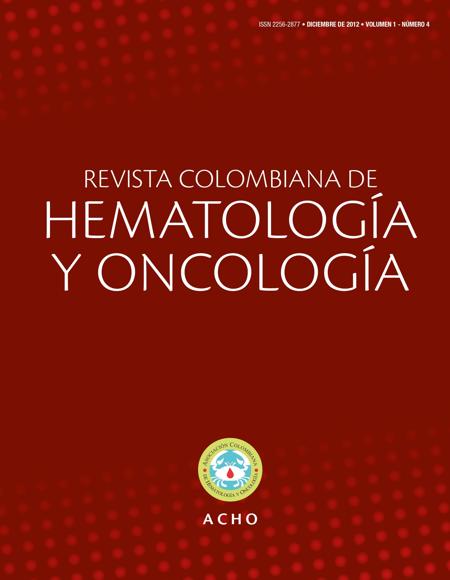aPTT sensitivity in the detection of coagulation factors deficiency.
Sensibilidad del TTPa en la detección de una deficiencia de factores de coagulación.

How to Cite
Download Citation

This work is licensed under a Creative Commons Attribution-NonCommercial-ShareAlike 4.0 International License.
Show authors biography
Objectives: Determine the sensitivity of aPTT reagent with Actin FSL for the detection of patients with clotting factor deficiency compared with the reference standard which is the direct determination of the level of coagulation factor activity by a coagulometric method at one step. Methods: Population: Patients from the Hospital Militar Central (Bogotá, Colombia) with aPTT determination by Actin FSL and clotting factor levels requested for suspected disorders of hemostasis during the period June 2009 to February 2011. Type of study: Analytic cross sectional of validation of diagnostic tests. All patients were administered the test to evaluate for Actin FSL aPTT and the gold standard, independently of their results. Results: From June 2009 to February 2011 were included 133 patients with aPTT by conducting Actin FSL and measurement of clotting factors concurrently. In the total study population, the sensitivity of the aPTT was 98.7% with a negative LR of 0.02. No patient with severe deficiency of coagulation factors (defined as a value < 1%) had a value of aPTT < 32.1 seg. Linear regression analysis showed no correlation between the percentage of activity of coagulation factors and the aPTT value in seconds. Conclusions: The sensitivity of aPTT with Actin FSL under a standardized technique has high sensitivity in the detection of decreased coagulation factors and a normal result is very unlikely to find any factor deficiency, by direct determination.
Article visits 345 | PDF visits 587
Downloads
- Proctor RR, Rapaport SI. The partial thromboplastin time with kaolin. A simple screening test for first stage plasma clotting factor deficiencies. Am J Clin Pathol. 1961;36:212-9.
- Chee YL, Crawford JC, Watson HG, Greaves M. Guidelines on the assessment of bleeding risk prior to surgery or invasive procedures. British Committee for Standards in Haematology. Br J Haematol. 2008;140(5):496-504.
- Pengo V, Tripodi A, Reber G, Rand JH, Ortel TL, Galli M, et al. Update of the guidelines for lupus anticoagulant detection. Subcommittee on Lupus Anticoagulant/Antiphospholipid Antibody of the Scientific and Standardisation Committee of the International Society on Thrombosis and Haemostasis. J Thromb Haemost. 2009;7(10):1737-40.
- Kitchen SM, Echenagucia M. Diagnosis of hemophilia and other bleeding disorders. Montréal, Québec: the World Federation of Hemophilia (WFH); 2010.
- Bowyer A, Smith J, Woolley AM, Kitchen S, Hampton KK, Maclean RM, et al. The investigation of a prolonged APTT with specific clotting factor assays is unnecessary if an APTT with Actin FS is normal. Int J Lab Hematol. 2011;33(2):212-8.
- Brandt JT, Arkin CF, Bovill EG, Rock WA, Triplett DA. Evaluation of APTT reagent sensitivity to factor IX and factor IX assay performance. Results from the College of American Pathologists Survey Program. Arch Pathol Lab Med. 1990;114(2):135-41.
- Shetty S, Ghosh K, Mohanty D. Comparison of four commercially available activated partial thromboplastin time reagents using a semi-automated coagulometer. Blood Coagul Fibrinolysis. 2003;14(5):493-7.
- Lawrie AS, Kitchen S, Purdy G, Mackie IJ, Preston FE, Machin SJ. Assessment of Actin FS and Actin FSL sensitivity to specific clotting factor deficiencies. Clin Lab Haematol. 1998;20(3):179-86.
- Bowyer A, Kitchen S, Makris M. The responsiveness of different APTT reagents to mild factor VIII, IX and XI deficiencies. Int J Lab Hematol. 2011;33(2):154-8.
- White GC 2nd, Rosendaal F, Aledort LM, Lusher JM, Rothschild C, Ingerslev J. Definitions in hemophilia. Recommendation of the scientific subcommittee on factor VIII and factor IX of the scientific and standardization committee of the International Society on Thrombosis and Haemostasis. Thromb Haemost. 2001;85(3):560.
- Chng WJ, Sum C, Kuperan P. Causes of isolated prolonged activated partial thromboplastin time in an acute care general hospital. Singapore Med J. 2005;46(9):450-6.
- Girolami A, Luzzatto G, Varvarikis C, Pellati D, Sartori R, Girolami B. Main clinical manifestations of a bleeding diathesis: an often disregarded aspect of medical and surgical history taking. Haemophilia. 2005;11(3):193-202.
- Favaloro EJ. Investigating people with mucocutaneous bleeding suggestive of primary hemostatic defects: a low likelihood of a definitive diagnosis? Haematologica. 2007;92(3):292-6.
- Kamal AH, Tefferi A, Pruthi RK. How to interpret and pursue an abnormal prothrombin time, activated partial thromboplastin time, and bleeding time in adults. Mayo Clin Proc. 2007;82(7):864-73.
- Ng VL. Prothrombin time and partial thromboplastin time assay considerations. Clin Lab Med. 2009;29(2):253-63.
- Ten Boekel E, Bock M, Vrielink GJ, Liem R, Hendriks H, de Kieviet W. Detection of shortened activated partial thromboplastin times: an evaluation of different commercial reagents. Thromb Res. 2007;121(3):361-7.
- Li J, Lai X, Yan C, Xu A, Nie L, Zhou Y, et al. Age-associated developmental changes in the activated partial thromboplastin time (APTT) and causes of prolonged APTT values in healthy Chinese children. Clin Chem Lab Med. 2009;47(12):1531-7.

















